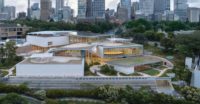Last Friday, in a talk that that was both humorous and sober, and touched on topics as diverse as the Three Little Pigs, the World Trade Center’s Twin Towers, and the earth as seen from space, astrophysicist and author Neil deGrasse Tyson closed Greenbuild 2017. The conference, organized by the U.S. Green Building Council, was held in Boston from November 8 through 10.
Tyson began by comparing this year’s hyperactive hurricane season to the Big Bad Wolf, saying that the severity of a string of storms that included Harvey, Irma, and Maria, was “way worse than wolf breath.” However, his freewheeling presentation focused not only on the destructive power of nature, but also on its ability to inspire awe. And, perhaps more significantly given his audience of green design and construction professionals, the talk celebrated the relationship between the natural world and the built environment, especially that of New York, where he grew up and continues to live today.
He explained “Manhattanhenge,” the term he coined to describe the phenomenon that happens when the setting sun aligns perfectly with the Manhattan grid. In 2002, Tyson first published the precise times to view the sun framed by the city’s concrete and steel canyons on the website of the American Museum of Natural History, where he is director of the Hayden Planetarium. Since then, in ever increasing numbers Manhattanhenge fans race out into traffic during the twice-annual occurrence to snap photos and watch the sun dip below the horizon. “It has gotten out of control in the most wonderful way,” he said. He described other, lesser known cosmic phenomenon involving architecture, including how the sun set on the observation deck of the old World Trade Center’s Twin Towers two minutes later than on the ground floor, due to the curvature of the earth and the height of the buildings.
Tyson also talked about images that changed the way much of humanity viewed the planet, including the so-called “Earthrise” photo shot from Apollo 8 in 1968. Considered by many as the most influential environmental photograph ever taken, it shows the earth as a small blue marble and highlighted both its beauty and fragility. He presented another, more recent image—one taken by the unmanned Cassini spacecraft which just ended its 20-year mission exploring Saturn in September. In the same frame, the photo captures Saturn’s rings and shows earth hundreds of millions of miles away, as a tiny spec of light. Before leaving the stage, Tyson entreated his audience “to preserve and cherish that pale blue dot.”









Post a comment to this article
Report Abusive Comment